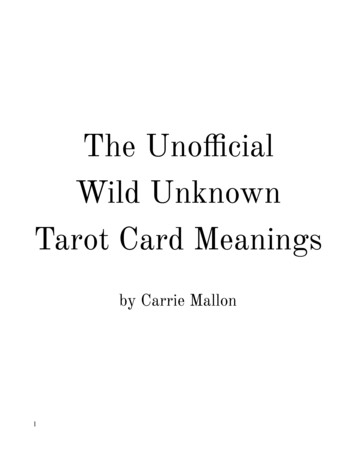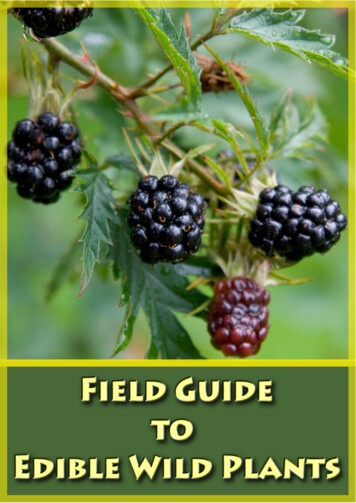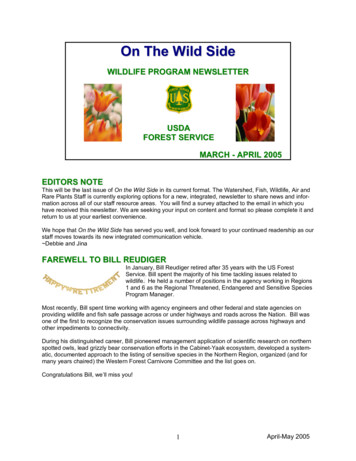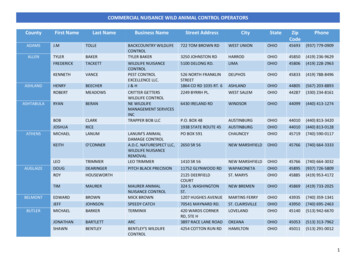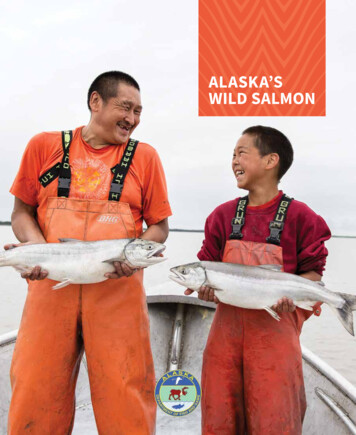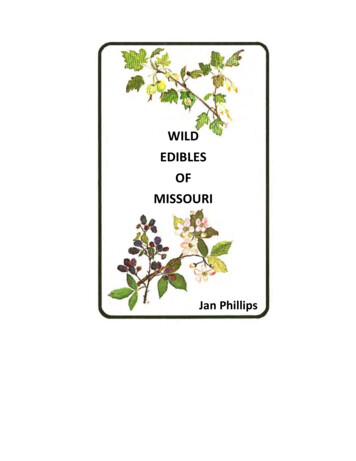
Transcription
WILDEDIBLESOFMISSOURIJan Phillips
WildEdiblesofMissouriJan PhillipsEdited by Bernadette DrydenDrawings by Cindie BrunnerPaintings by Jan PhillipsPublished byThe Missouri Department of Conservation
To my “wild” familyAbe, Sheli, & Janette who ate the weeds dutifully Second EditionCopyright 1979, 1989, 1992, 1995by The Conservation Commission of the State of MissouriEqual opportunity to participate in and benefit from programs of the MissouriDepartment of Conservation is available to all individuals without regard to their race,color, national origin, sex, age, or disability. Complaints of discrimination should be sentto the Department of Conse rvation, P.O. Box 180, Jefferson City, MO 65102, or U.S. Fish &Wildlife Service, 18th and “C” Streets, NW, Washington, D.C. 20240, Missouri Relay Center:1-800-735-2966 (TDD)ii
introductionIn the many years of my teaching career I have been involved withan educational philosophy of teaching in which the curriculum isinterdisciplinary and presented in an adventurous, experiential manner.This work has, indeed, been my adventure!I was placed in a situation which impelled and required me to learnnew skills. Those newly acquired skills of researching, recognizing,identifying and using edible plants were meaningful beyond myprevious range of knowledge and required a great deal of planning a nddecision making. The feedback was immediate as my family either ateor rejected my edible dishes. The information needed to be organizedinto a book for my thesis which reflected upon the entire three years'experience and linked practice with theory. The additional challengewas to imagine that my book might be published.The adventure could have ended on that note, yet, unimagined atthe time, another total adventure was waiting. The editor stronglyurged me to illustrate my work. In trying to portray the edibles, I haveexperienced the agony and ecstasy of painting. I am certainly not anartist and have no art class exposure, which will be evident in thepaintings. Indeed, these have been a stress -challenge activity in whicheach painting will show the agony of trial and error and the ecstasy ofhaving completed it. This has been an adventure!Therefore, this book is a labor of love. The results were obtained byexcitedly and painfully keying out plants, learning through mistakes,celebrating new finds. I wish I were a botanist, or even a person with agood background in plants; instead I am an avid lover of the out-ofdoors whose hope it is to arouse some curiosity and interest in closerobservation of nature's tremendous supply of plants.iii
This research was basically conducted on plants within Missouri, yetvacation travel has proved the availability of many of the same plantsthroughout much of the Midwest.CAUTIONS for various plants have been included, not with theintention of scaring anyone awa y from trying the plant, but as awarning to always identify your plant carefully before you eat it. It isessential that you know poisonous plants before collecting edible ones.Some people may be sensitive to the chemicals contained in and onvarious plants while others show no effect. Incidentally, our domesticpotato and rhubarb have poisonous parts. It would be a shame had wethrown the edible out with the inedible. I am intrigued and bewilderedby the considerable discomfort which our forefathers must haveexperienced while identifying those plants which were not fit forconsumption!Many of the plants have fascinating life histories concerningpersonal uses, folklores or medicinal qualities. Such colorfulback-ground information is included strictly as points of interest - NOTas a suggestion that you become your own herb doctor!While knowledge and uses of the wild edible is exciting and certainlya conversation piece, abandonment of your local grocery is not inorder.An exorbitant amount of time is required to locate, pick, clean andprepare wild edibles. I have spent seven hours picking and cleaning asalad for a Wild Food Party for eight. If dreams exist in your mind ofbecoming self-sufficient and living off the land, know that the energyspent in securing the food is rarely replaced by the resulting meal.But be assured also that you are in for some fascinating adventures,some moments of stress, minutes of insightful realizations, hours ofawe, days of wonder and a lifelong appreciation of the beauty andmiracles found in the world of plants.Jan PhillipsMarch 1979iv
acknowledgmentsMuch love to my mother, Jewell Robinson, who “planted” my loveand awareness for the out-of-doors and whose recipes and insights areabsorbed within this book. A special thanks to Bill McConnel of WebsterCollege who allowed and encouraged this work.A grateful thanks for the outstanding work of Julian A. Steyermark,Flora of Missouri, from which I freely pulled and used informationregarding habitat, location and length of flower bloom.I am compelled to express an appreciation for Fernald and Kinsey'sbook, Edible Wild Plants of Eastern North America, which wasinvaluable.Many thanks to the St. Louis County Parks and RecreationDepartment whose parklands were utilized for a good deal of myresearch.Love and thanks to the Woods, Morleys, Mclntires and Naus - whoconsented to be guinea pigs at my wild food parties and whose laughteraided me through this research.My sincere appreciation to the Missouri Department ofConservation for publishing this book so that the contents may beshared with others.A particular embrace to Michael McIntosh, publications editor,whose encouragement was instrumental in providing the necessaryconfidence for my paintings. His i deas, editing and joshing wereappreciated.v
prefaceThe purpose of this work was to locate and experiment withMissouri's wild edibles. This I have done.The edibles are arranged by the plant's flowering color: 1) white; 2)yellow, cream and orange; 3) green; 4) brown; 5) red, also pink andlavender; 6) blue and purple.Each plant has a botanical name attached. The length or season ofthe flower bloom is listed under “Flowers.” “Habitat” refers to the areaswhere that particular plant prefers to grow, which gives a clue whentrying to locate it. “Location” is a reference to where the plant iscommonly found in Missouri. “Collection” tells when the plant is edibleor ready to be picked, pinched or dug. My hope is that several of the“Uses” or suggested ways to prepare the wildings will be tried byothers. “CAUTION” is a warning for possible poisonous or rashproducing plants or parts of plants.Wild Edibles of Missouri may seem to be a contradiction on theconservation of plants. While most sources suggest that plants beprotected from destruction, this book advocates that the plant be used.Selected and careful use of wild edibles is imperative, both from theview of the plant as well as that of the user. Because of possible sideeffects, all wild edibles should be eaten in moderation! Because of fearof eradication, all edibles should be picked in moderation!Fruits, nuts and berries may be gathered with little fear of anydamage. However, additional attention should be given to plants thatare either pulled or dug up. While good judgment must be exercised toassure the continued existence of any plant, danger does exist from thethoughtless collector who wipes out an entire colony. Pick specimensthat will least affect that plant's continued reproduction.Whenever possible, bits of roots and rhizomes should be replantedor the seeds scattered in the disturbed earth as some insurance forreplacing any damage done.You can practice good conservation habits and reap the harvest,too.“A seed has an awesome responsibility, but it's superbly designed todo its task.” (from Living Water, Brown & Cavagnaro)Enjoy the wonders it produces.vi
white-flowering edibles1
Arrowhead(Sagittaria various species)FLOWERS: May - OctoberDESCRIPTION: Water plantwith erect, arrow-shapedleaves. Belongs to the WaterPlantain Family.HABITAT: Shallow water,edges of pondsLOCATION: ScatteredstatewideCOLLECTION: August NovemberUSES: VegetablesArrowheadisanattractive plant growing onthe border of one of theponds at our farm. Thearrowheadleavesaredistinctive, as are theattractive flowers.The food source fromarrowhead is a potato-liketuber that produces in theautumn. One reading sourceindicated that the Indians harvested the arrowhead, or duck potato, byslushing around the pond with their bare feet. Once the foot felt a tuber, itwas knocked loose and picked. The tubers, which can become an inch or twowide, are located several feet from the plant itself. While most of the tubersare smaller, they all contain a bad tasting, whitish-colored juice when eatenraw.One way to prepare this potato substitute is to bake it in a 350 oven for30 minutes. They may also be boiled or roasted around a campfire. Fernaldreports that one Indian tribe used the tubers all winter by stringing them upto dry.2
Yucca(Yucca smalliana)FLOWERS: May - JulyDESCRIPTION: Long, narrowleaves are tough and sharp,growing 2' long from a basalrosette. Tall flower stalks bearcream or white flowers.Member of Lily Family.HABITAT: Scattered fromgardens along roadside,railroads, open banks, openwoodsLOCATION: Scattered sparinglyCOLLECTION: May - AugustUSES: Salad, fritter, vegetableMy side garden has a coupleof yucca plants which haveprovided enough food for myexperiments.The flower petals are veryacceptable in a salad andespecially pretty when usedwith rose and violet petals. I useasweetenedmayonnaisedressing thinned with a fruit juice on this salad.The flowers make a reasonably good fritter when dipped in a batter of 1cup flour, 1 t baking powder, ½ t salt, 1 cup milk, 1 egg, ¼ cup corn oil andfried.The yucca pods of some species are edible and supposedly quite delicious.Our common yucca of Missouri is indeed not a delicacy, or, that is to say, Ihave not developed a taste for it. The roasted pods, while edible, are bitter. Ialso roasted the pods, scraped out the seeds into a batter and fried that. Allattempts at boiling, roasting, camouflaging or frying were unsuccessful.If I were hungry or lost and located some yucca, I would eat them again.Until then, however, they will remain on an emergency-food-only basis.3
False Solomon’s Seal(Smilacina racemosa)FLOWERS: May - JuneDESCRIPTION: Bending stalk;alternate, parallel-veinedleaves; flowers cluster onstem end. Member of LilyFamily. early May.Midsummer for berriesHABITAT: Rich woodlandLOCATION: StatewideCOLLECTION: late March early May. Mid-summer forberriesUSES: Vegetable, berryCAUTION: The fresh berriesact as a purgative.The young shoots of falseSolomon's seal and trueSolomon's seal are close as look-alikes, grow in the same areas and areinterchangeable as an asparagus vegetable. Cut off the young shoots, cook forfive minutes in boiling water and serve with butter. It may be fancied up byusing in a casserole.Indian tribes used the rootstalks as a potato after soaking them in lye waterand boiling until tender.False Solomon's seal has a flower cluster at the top of the stem while thetrue species has flowers at each spot where the leaf attaches to the stem. Theyoung shoots are differentiated by the true Solomon's seal having more nerveveins in the leaves — a help when gathering plants prior to blooming.The berries, which are white when unripe, turn a reddish-purple splotchedwhen ripe. The berries may be eaten raw. Taken either with other fruit orhoney, they aid in problems of constipation. If you are a camper who isaffected by this situation, a mid-summer hike in pursuit of false Solomon'sseal berries might be an effective remedy.4
Solomon’s Seal(Polygonatum canaliculatum)FLOWERS: May - JuneDESCRIPTION: Arched stem bearingalternate, parallel-veined leaves.Leaf base clasps stem. 2-10 flowersdangle from attachment at leaf.Member of Lily Family.HABITAT: Along stream, roadsides,railroads, rich shaded, rocky woodsLOCATION: StatewideCOLLECTION: SpringUSES: VegetableSolomon’s seal is a beautifulplant. Most of the plants I’ve seenare approximately 2½' tall. Whilecamping with Cadet Scouts atGreensfelder Park I located a fatstemmed stalk that was 5' tall andin bloom! The cute dangling flowershang under the leaves.The young shoots should beboiled in a small amount of water,steamed for three minutes andserved with butter. While the plantis good, I believe I prefer seeing it to eating it.The rootstalk of Solomon’s seal can be dried and made into a floursubstitute. The rootstalk has large circular scars, which identify anddistinguish it from the similar and poisonous root-stalk of the mayapple.What an interesting history of uses follow this plant! It is reputed tocorrect all kinds of female problems, serve as a soothing bath for poison ivyitch and as a poultice for external infections and wounds.5
Smartweed(Polygonum hydropiper)FLOWERS: May - NovemberDESCRIPTION: Thickened joint atleaf attachment, surrounded witha wrap. Leaves are elliptical,alternate, smooth. Member ofBuckwheat Family.HABITAT: Fields, pastures, moistground of streamLOCATION: Scattered state- wideCOLLECTION: April - NovemberUSES: Pepper substituteCAUTION: See page 205After reading that smartweedhad peppery leaves, I collectedthe leaves of the pink-floweringvarieties. I found them all butwithout a pepper taste. I laterdiscovered the white floweringsmartweed had a very pepperyflavor. The leaves may be usedfresh or dried as a substitute for pepper.6
Pokeweed(Phytolacca americana)FLOWERS: May - OctoberDESCRIPTION: Leaves arelarge, pointed tip, alternate.Thick stems become purplewith age. Flower cluster onstem opposite the leaf.Member ofPokeweedFamily.HABITAT: Waste ground,farm lots, thickets, arounddwellings, roadsides,railroads, borders of woodsLOCATION: StatewideCOLLECTION: April - June forgreens; berries only whenripe in August until frost.USES: Potherb, vegetable,pickle, coloringCAUTION: See page 206A friend of mine who lived in the South corrected me one day when I wastelling him about pokeweed. “You mean poke salat” (pronounced sallat). Imust agree, it is a better name.Early spring finds many a forager out combing the hillsides for poke, dock,dandelions, mustard, peppergrass, lamb’s quarters or whatever the favoritegreens combination might be. Poke is generally the main bulk of the pot as itis tasty although not strong-flavored. It is good by itself or mixed with theothers.7
The large root, which is poisonous and not edible, works overtime keepinga supply of poke above ground. When you locate your poke patch, cut theshoots off near the ground, return a few days later for another batch. Thereare those who grow poke in a basement hotbed to provide this vegetable foryear round use. I freeze the poke stems after blanching for my winter’s use.However, I must admit I do not care for the frozen variety as those I’ve put updo not begin to approach the fresh source in taste.The uses of poke are varied. As a green, it should be thoroughly cooked intwo waters. Eaten raw, it will make you sick!The shoots when young are an excellent vegetable served as asparagus orcut in small rounds, rolled in corn meal, and fried like okra. My family isenthusiastic about the poke stem okra. For another dish, peel off the outer,fiberous layer of the stem and cut in 3 or 4 -inch sections. Boil in salted waterand serve with a pat of oleo. Presto! You have poke stems asparagus style.The stems of the poke are a part of my dill crock. The stems must bepeeled and rid of the outer rind which is bitter and tough. I layer the pokestems on dill, onion, garlic, hot peppers and wild grape leaves, separating thisvegetable from the other pickling edibles. The brine is one part salt, ½ partvinegar and ten parts water. After allowing the mixture to set and ferment fora couple of weeks, pack into sterilized jars and seal.I find one caution advisable to follow when preparing poke stems. Oldtimers say that when the stems begin to purple, the root’s poison is going upthe stem. Therefore, I use the stems that are green with very little purplecoloring on them. An overdose of poke is a sure laxative. It is a good idea tocook poke in at least two waters to help rid the greens of any toxicsubstances.A worthy meal can be made with poke and a cheese sauce to which greenpeppers and hard-boiled eggs have been added. Cook your poke in the twowaters recommended earlier for five or ten minutes each. In a greasedcasserole put some poke, layer with sliced hard-boiled eggs and greenpepper, poke layer, egg/green pepper layer and end with the poke. Makeyour cheese sauce by blending 6 T flour into 6 T melted oleo. Add 2 cups hotmilk, add salt and pepper to taste. Stir in 1 cup grated cheddar cheese andpour over your layered casserole. Bake for 30 minutes at 350 . I expect this tobe tried again and again!!As a spinach-nutmeg vegetable, poke is delicious. Cook your poke in twowaters. Melt a couple of tablespoons of butter and sauté some minced onion.Blend in 1½ T cornstarch in a cup of milk and add ¼ t nutmeg. Simmer withthe poke and season with salt and pepper. This should take about fiveminutes. Add ¼ cup of cream, allow it to start to boil, remove from the heatand serve hot. I must say this is yummy, but I must also admit that two out ofthree times I had stomach cramps and bathroom problems follow-ing thisdish. Could I have eaten too much? Consider yourself warned!8
The ripe berries of poke were used by the Portuguese to give a darkercolor to their Red Port Wine. However, it also gave a disagreeable flavor tothe wine. As a result, by order of the King, poke was cut before the berriesformed. The green berries are reported poisonous. The ripe ones, therefore,I’ve used cautiously in jelly and as a food coloring for a cake icing. While I’vehad no ill effects, I suggest that one be aware that there is reason to be leeryof this; there is a slightly bitter, disagreeable quality that lingers after theinitial sweet taste disappears. Go sparingly of this fruit of the pokeweed. Imean, poke salat!9
Spring Beauty(Claytonia virginica)FLOWERS: February - MayDESCRIPTION: Grass-likeleaves, purplish cast andgreen. Terminal flower withseedpods left on stem, resultof old blooms. PurslaneFamily.HABITAT: Meadows,wooded areas, hillsidesrocky ledgesLOCATION: StatewideCOLLECTION: February - MayUSES: Vegetable, salad,potherbOne of the first springwildflowers to show its fivepale, pink-tinged petals isthe spring beauty. This wellnamed plant provides a bounty of beauty in the woods as well as in openareas and yards. The early leaves are purplish and green and may be eatenraw in a tossed salad. Later, the leaves may be boiled in sal ted water andserved with butter or lemon juice as a potherb.The “fairy spud” is a tuber growing about three or four inches belowground. They range in size from 1¼ inch to two inches and grow in unusualshapes. They are enclosed in a jacket somewhat like our potato, only smaller.Hence the name “fairy spuds.”These small potato-like tubers are prepared in a variety of ways, as youwould any potato. My first experience was to boil the tubers for ten minutes,pop off the outer jacket and douse in butter. I was very disappointed in themusty taste and smell. My family really turned up their noses at this dish.Therefore, the rest of my efforts were geared to a single serving. Unless youfind a rich, humus hillside, fairy spuds are difficult to gather in qua ntities, sosmall servings were to my liking. The small potato is good fried in oil with saltand pepper.10
Since fields of spring beauty can be easily located, I’ve included thiswilding in my spring camping menu. Students have eagerly dug up theunderground treasure in a true spirit of pioneer adventure, but the amountnot consumed would indicate that less active pioneer taste buds exist!Personally, I have grown more fond of the tuber the more I’veexperimented with it. Nonetheless, it is a food source I will use as a campingnovelty or in hunger emergencies, not as a vegetable choice.Chickweed(Stellaria)FLOWERS: January - December flower.Each of the five petals deeply cut.Leaves in pairs, small, usually notstalked. Pink Family.DESCRIPTION: Small flower. Each ofthe five petals deeply cut. Leaves inpairs, small, usually not stalked. PinkFamily.HABITAT: Lawns, gardens, arounddwellings, waste ground, roadsides,railroadsLOCATION: StatewideCOLLECTION: January - DecemberUSES: Potherb, soup, casserole, saladChickweed is a remarkable plant. Ithas the ability to remain above groundall winter; it therefore yields an ediblesource year ‘round. Chickweed is oftena nuisance in the yard, but it pulls outvery easily as the roots are shallow,thin and loose. Surprising that itsurvives all winter, isn’t it?11
The young tips of the stems are used raw in salad, boiled alone are aspinach substitute or added to a mess of spring greens. As a spinach, you mayapply butter generously or season with bacon crumbs and vinegar after ashort boiling period with only a small amount of water.I’ve had very satisfactory results substituting chickweed in a spinach ricecasserole. This is delicious and fancy enough for any dinner party. Add all ofthe following ingredients to a greased casserole: 1 cup bouillon, 1 cup water,1½ t minced onion (wild, perhaps), ½ t salt, dash pepper, 1 cup freshchickweed, ½ cup rice, ½ stick oleo, ¼ cup grated cheddar cheese. Bake at325 for 45 minutes for a taste bud treat!Chickweed also makes an interesting addition to a dish of scrambled eggs.Just add the chickweed to the egg batter along with 1½ T Durkee’s dressing,salt and pepper. The result is scrambled eggs chickweed style.One of the favorite ways to prepare chickweed for my family is to make asoup. Add a cup of chickweed to 4 cups of milk, 4 T chopped onion, 3 Tcornstarch, 2 T butter, salt and pepper. It is delicious. Now, get the chickweedout of your yard and onto the table!!!12
Mayapple(Podophyllumpeltatum)FLOWERS: April - MayDESCRIPTION: Bare stem toppedwith large, palmate leaves. Theone or two leaves look likeumbrellas. Forked stem of thetwo-leafed plant produces asingle flower. Barberry Family.HABITAT: Low moist or dry openwoods, thicketsLOCATION: StatewideCOLLECTION: July - AugustUSES: Fruit, pie, marmalade,jelly, drinkCAUTION: See page 207Early spring finds the mayapple spiraling up to form a forest floor ofumbrella plants. The plant has either one leaf or it forks midway on the stemproducing two leaves. It is the double-leaf plant that flowers and producesthe mayapple, or wild lemon as it is often called.This is an easily acquired fruit. It gets about the size of a small lemon andfalls to the ground. While the golden brown tones easily camouflage into theforest floor, once the plant is located, the fruits will be almost directly underit. The raw fruit has a thick flesh that surrounds the many seeds and isparticularly sweet.13
A chiffon pie made from the raw pulp was fairly good, but takers were notoverly eager. The pie was greatly improved by first cooking the mayapple,putting the pulp through a colander and using the same recipe as follows:Cook 40-45 mayapples for 1½ cups of pulp. Add ¾ cup sugar to pulp and letstand 20 minutes. Soften 1 envelope unflavored gelatin in ¼ cup cold waterthen dissolve the mixture in ½ cup hot water. Cool and add the mayapplemixture, 1 T lemon juice, and a dash of salt. Chill until partially set. Fold in apackage of whipped cream, pour into a graham cracker crust and chillthoroughly.Mayapples make a very tasty greenish-yellow marmalade. Cut off bothflowering and stem end of the mayapple and quarter into a large pan. Simmerfor 15 minutes and use a colander to get the pulp. For two cups of thick pulp,add ½ package of Sure-Jell and 2¾ cups of sugar. When the mixture boils andthickens, pour it in-to jars and seal.A good jelly which is excellent to serve with venison or mutton is made byadding green food coloring and mint with the mayapple for a mint jelly.A good drink may be had by peeling and chunking the mayapples into alarge bowl. Add sugar and let the mixture set to draw out the juice. Mash themixture and run it through the colander. Now, add a jigger of this liquid to aglass of lemonade for a pleasant iced beverage. Other friends prefer to addhalf of the juice to a half portion of grape wine and I must admit it’s no t badthat way at all!The rest of this attractive plant is reported to be poisonous and best leftalone. The Indians used the root, however, as a medicine.It’s a shame to see this fruit fall and rot. The animals seem to enjoy themayapple, why not you and I?14
Peppergrass(Lepidium virginicum)FLOWERS: February - NovemberDESCRIPTION: Branching stems withflowering tips that grow, leavingseedpods on stem. Leaves aretoothed. Mustard Family.HABITAT: Fields, pastures, prairies,yards, roadsides, railroadsLOCATION: Scattered statewideCOLLECTION: February - NovemberUSES: Salad, potherb, soupThere is little reason to questionthe name of this plant after eating it.It has a hot, peppery twist I findappealing.My front yard supports this plantand allows it to be a regular on ourdinner table. I use the peppergrassleaves, stems, flowers, seedpods andall in a green salad to be eaten raw, or wilted with a leaf lettuce. Although Iprefer peppergrass uncooked, it may be added to the greens pot.The seedpods are also good sprinkled on soups or used in a vinegar -oilsalad dressing. In the fall, the dried peppergrass stems and pods can be easilygathered. (They enter the aesthetic area and make an attractive addition to adried arrangement.) By running your fingers down the stem, both seeds andpods pop off into a box. These reddish seeds can be obtained by winnowingthe pods out. Now, I have stated the dried peppergrass is easy to pick. Let meassure you that does not go for the winnowing process. This is a very slow,time-consuming process when done by hand. I spent two hours getting a littlemore than enough to fill the space of a quarter. Nonetheless, the seed isworthy of some effort. One gentleman suggested I check a mill about sortingout the seeds. I’ll remember that. Only wish I’d thought of it earlier!15
Shepherd’s Purse(Capsella Bursa-pastoris)FLOWERS: January - DecemberDESCRIPTION: Rosette structure ofleaves has a single stem, floweringat tip and leaving seedpods onstems as tip grows. Mustard Family.HABITAT: Fields, pastures, lawns,roadside, railroadsLocated: StatewideCOLLECTION: Leaves, February April; Seeds, June -SeptemberUSES: Salad, potherb, vegetable,breadstuffShepherd’s purse differs frompeppergrass in the branching andpod structure. Shepherd’s pursehas heart-shaped or old-fashionedshepherd’s purse pods while thepeppergrass pod is more round.Peppergrass has several branchesoff the central stem while shepherd’s purse sends a single stem up from itsrosette. The two are, however, interchangeable in preparations.The young leaves, flowers, and seeds may be wilted, made into slaw orused in a tossed salad. The peppery twang of the green leaves has given itanother name of “salt and pepper.”Shepherd’s purse may be boiled as a potherb or tossed in a bacon grease,crumbs, vinegar and water solution and simmered.The seeds of this plant were gathered by Indians and ground into a mealfor breads.It is reputed to be an excellent check against internal hemorrhaging andhemorrhoids. For this medicinal tea, stir a large teaspoon of leaves in a cup ofboiling water for half an hour. Drink cold, two or more cups a day. Good? Oh,well, it’s good for you!16
Water Cress(Nasturtium)FLOWERS: April - OctoberDESCRIPTION: Branched, bushy. Thick, juicystem, tiny white flower cluster (flat) on stemend. Leaves opposite and divided. MustardFamily.HABITAT: Springs and spring-fed streamsLOCATION: Southern and central MissouriCOLLECTION: January - DecemberUSES: Salad, soupWatercress is a delicacy to be sure. Fondmemories of wilted watercress, which camefrom a nearby spring, are part of my growingup. My mother would fry two strips of bacon,crumble them over the water cress and wiltthe mess by bringing to a boil equal amountsof bacon grease, vinegar and water. She added1 T sugar and a dash of salt to the boilingmixture and poured it immediately over thefresh greens.These are fascinating stories of the effectsof water cress ranging from the ability to expelworms, kill the unborn child, act as an aphrodisiac, or good for a derangedmind. I tend to agree with the last effect as I’m sure that anyone eatingwatercress has a more pleasant outlook just commenting on how good it is.Some cautions are worth mentioning when picking watercress. If there isquestion that the water in which it grows might be contaminated, it isadvisable to soak the cress in water with a water-purifying tablet. Also, besure you can recognize poisonous water hemlock and avoid that plant in yourpicking.As avid canoe floating enthusiasts, we often pick a small handful ofwatercress to have with our “camp salad” that evening. It adds a peppery zingto the meal.17
Watercress can be used raw in salads or sandwiches, or it can be cookedas a potherb. I do not recommend the latter. Angier gives a great soup recipefor watercress. Add 1 cup chopped watercress to 3 cups milk which has beenheated with 1½ t salt. Simmer for five minutes. Beat at last minute before youserve and add another cup of milk or cream which is allowed to heat. Topwith a dash of paprika and a sprig of cress. Also good when ½ cup is added toyour regular scrambled eggs.Bitter Cress(Cardamine pennsylvanica, C. parviflora)Spring Cress(Cardamine bulbosa)FLOWERS: March - JuneDESCRIPTION: Basal leaves,alternate on smooth stem. Small, 4petal flower. Mustard Family.HABITAT: Wet woodland, wetmeadows, around springs, moistledgesLOCATION: Southern and centralMissouriCOLLECTION: March - JuneUSES: Salad, horseradish substituteThese cress plants add anotherflavor tingle to your wild saladbowl. The spring cress has a hint ofhorseradish, but both are welcomeand interesting as edible
Wild Edibles of Missouri may seem to be a contradiction on the conservation of plants. While most sources suggest that plants be protected from destruction, this book advocates that the plant be used. Selected and careful use of wild edibles is imperative, bot



